By Tre McClellan, Lis Katherine, and Carina Soria-Romero
What is the Understory?
The rainforest consists of a variety of plant species in many layers, the emergent, canopy, understory, and forest floor.
The Emergent layer: The top of the rainforest where trees, plants, and leaves obtain the most sunlight. Due to this they face very high temperatures, rain, and wind that led to specialized adaptations.
The Canopy layer: This layer is very dense. It is roughly ~20ft thick. This layer has the ability to block out sunlight, rain, and wind. This creates a darker and more humid environment for ther layers below the canopy.
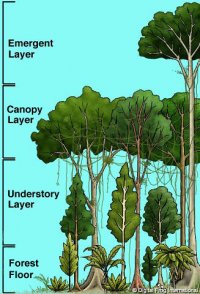
The Understory layer: However, the understory only receives about 5-10% of sunlight. Although raindropsare able to pass through the leafy tree canopies and contact the understory plants, it is difficult for these plants to obtain sunlight due to the thick structures of the canopies. The understory is warm, wet, and shaded in which plants have adapted to this specific environment.
The Forest Floor: This layer only takes about 2% of the entire rainforest. This layer is very dark, hot, and damp;
Major Adaptations in the Understory layer of the Rainforest:
- Anthocyanin
- Drip tips & leave size
- Waxy Cuticles
Anthocyanin
Q: What is the red pigment under some rainforest plants?
A: The red pigment is called anthocyanin, and it is exhibited in some of the understory plants in the abaxial (underneath) tissues. Anthocyanin has many different purposes, and was originally thought to be a mechanism for enhancing transpiration by increasing heat absorption. It has now been determined that anthocyanin in these understory plants help increase photosynthetic efficiency. Anthocyanin is located in a single layer of cells immediately below the mesophyll, which contains many chloroplasts. Cyanic layers can improve photosynthetic energy capture by back-scattering additional light through photosynthetic tissue. Cyanic leaves have an increased reflectance, around 650nm-750 nm compared to green leaf species. Plants in dimly lit environments of the rainforest are likely to possess adaptations to increase their light utilization efficiency. Red understory plants must have specific characteristics to absorb black-body infrared radiation, radiating 4nm-50nm with optimal around 10 nm. Juvenile plants are often seen with a cyanin adaptation, as they are in the depths of shade. They will then lose its red pigment as it reaches maturity, and can sit above other vegetation.
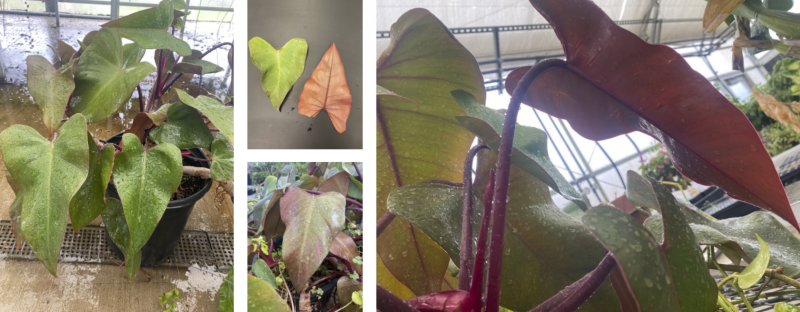
Philodendron, showing red undersides of leaves.
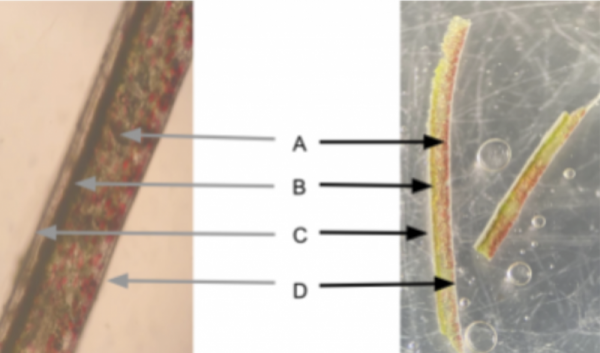
Cross section of a Philodendron leaf that contains anthocyanins. A) Spongy mesophyll with anthocyanin, B) Palisade mesophyll, C) Upper cuticle, D) lower cuticle.
Drip Tips and Leaf Size
Q. How do drip tips benefit the understory layer?
A: They allow the understory and forest layer to have access to water and prevent any fungi, moss, and lichens from taking over the leaves. Additionally, drip tips allow the water to fall off quickly, so they can capture as much sunlight as possible.
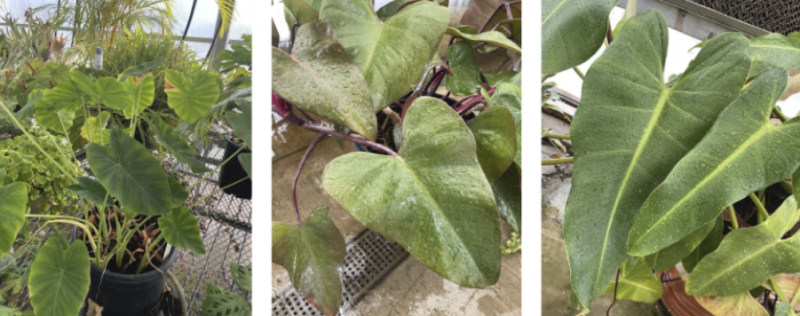
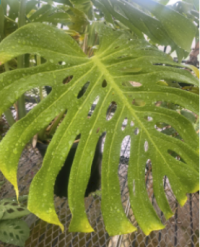
Q. Why does the “swiss cheese” plant have holes in it?
Heteroblasty: it is the sudden change in morphology in the development of the plant. The change is related to leaf size/shape, shoot orientation, internode length or the production of adventitious roots. Plants and leaves must make adaptations in order to survive due to the rainforest climate conditions For example, the “swiss cheese” leaves have holes to help them cool down due to the hot climate in the rainforest canopy.
Q. Why are the understory plant leaves so wide?
There are a variety of different leaf sizes throughout the different layers. This depends: on the sun, wind, and rain. Plants that grow in the understory layer tend to have large leaves. This helps them capture the little light available in this dark environment since the understory layer only gets 5% of the rainforest's sunlight.
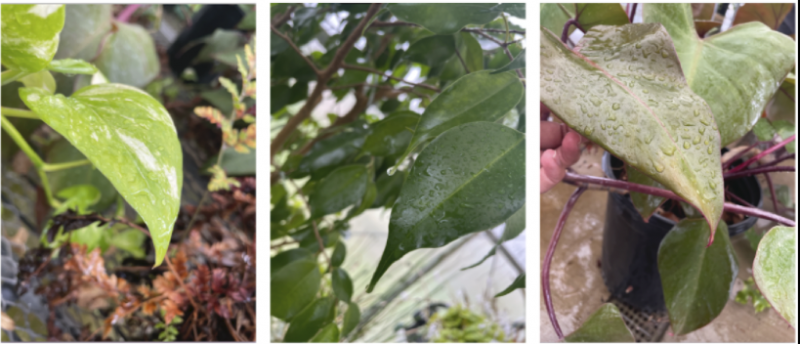
Above: several examples of leaves with drip-tips.
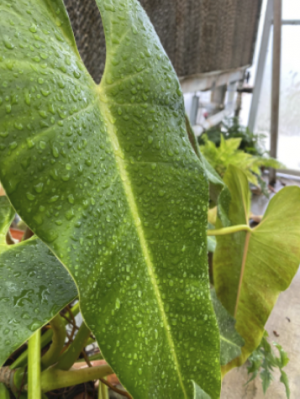
Waxy Cuticles
The waxy cuticle is the outermost layer of understory plant leaves. This layer consists of many important substances, such as cutin, polysaccharides, waxes, and lipids. Each of these substances contributes towards the protection of the understory plant leaves. For example, cutin forms a hydrophobic layer that helps keep the leaf intact and prevents it from disintegrating in water. The waxy cuticle also plays a role in signaling pathways for growth and development and in plant defense.
The waxy cuticle causes water to form discrete droplets, rather than spreading out.
References:
- How Did the Swiss Cheese Plant Get Its Holes? https://www.zoology.ubc.ca/files/Muir_2013.pdf
- What advantage does the waxy cuticle provide to the leaf? https://homeguides.sfgate.com/advantages-waxy-cuticle-provide-leaf-92502...
- Multifunctional roles of plant cuticle during plant-pathogen interactions https://www.frontiersin.org/articles/10.3389/fpls.2018.01088/full
- Trade‑offs between light interception and leaf water shedding: a comparison of shade‑ and sun‑adapted species in a subtropical rainforest Fengqun Meng · Rui Cao · Dongmei Yang · Karl J. Niklas · Shucun Sun: https://link.springer.com/article/10.1007/s00442-013-2746-0
- Abaxial Anthocyanin Layer in Leaves of Tropical Rain Forest Plants: Enhancer of Light Capture in Deep, Shade: https://www-jstor-org.libproxy.csustan.edu/stable/pdf/2388175.pdf?refreq...
- Drip Tips and Lance-Shaped Leaves: https://northernwoodlands.org/outside_story/article/drip-tips-and-lance-...
- Advantages of the Waxy Cuticle: https://homeguides.sfgate.com/advantages-waxy-cuticle-provide-leaf-92502...
Updated: August 08, 2023